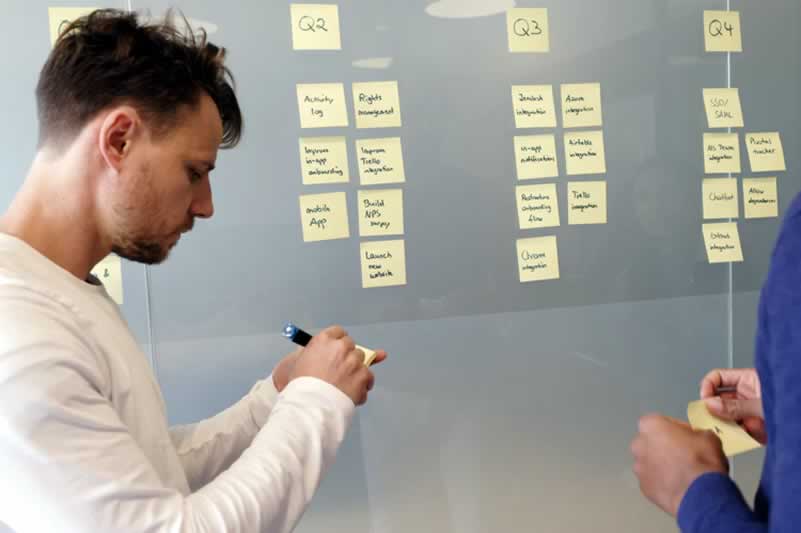Software development methodologies are basically algorithms of the development process. They regulate what happens and in what order. Different software development methodologies offer different approaches, along with particular advantages and disadvantages. To maximize the efficiency and the end result quality, it’s very important to choose the one that suits your requirements and can be easily utilized by the team.
Software design methodology allows the programmers to systematize the whole project from the beginning. Most of them include the planning stage and dictate which particular development aspects go after each other. Some of them are repeated in particular software design methods, some are not.
That’s what distinguishes them from each other. As said before, they all suit certain purposes, meaning that they focus on separate aspects of the project. For example, Agile focuses on regular discussions between team members for receiving feedback and improving the quality and performance. But Waterfall is just a simple step-by-step algorithm of sequential instructions.
Experienced programmers and professional custom software development services have already tried most of the software design methodologies. They know the differences and when to switch between them. But beginner devs often choose the wrong ones and fail to effectively develop the product because of it.
So, to help all the aspiring program creators out there, we made a list of the best methodologies.
Waterfall
Let’s start with the Waterfall. It’s probably the easiest to understand and the most linear of them. It’s a simple plan that consists of 6 instructions:
- Analyzing the requirements
- Creating the design
- Implementing everything
- Testing
- Deployment and verification
- Maintaining the ready product
It’s what could be called the traditional method. You analyze what you need to do, then you create a general (and detailed) design of the program, outlining everything and defining how it will look. Creating a template of some sort. Then, you write the code itself and implement all the features you need.
Now, test it for bugs and other issues to make sure everything works as intended. After that, you just need to verify that it fits the requirements and is ready to be released. From now on it’s just a matter of keeping the application in working condition.
This algorithm fits inexperienced teams the best, as it’s very easy to understand. However, to be able to use it efficiently, the team needs to clearly understand the objectives and follow instructions precisely.
Rapid
Rapid, also known as RAD, maximizes the speed of the development process and allows its users to adapt to the constantly changing circumstances on the market. It works like this:
- Requirement analysis and planning
- Construction of the code
- User design
- Creation of the prototype
- Repeat 2,3,4
- Testing
- Cutout
The repetition of the construction, design development, and prototype creation allows you to easily and rapidly adjust and change whatever you need. In this fast-paced world of software, it’s the perfect methodology to be always ready for unpredictable circumstances.
But keep in mind that you need experienced developers who know what to do as well as big budgets in order to benefit from using Agile. That’s because the teams need to be able to approve each new application version that comes after the repetitive construction cycle.
Agile
Agile software design methodology looks somewhat similar to our previous mention, Rapid. It depends on the repetitive process too, due to which different iterations of the single program with small adjustments and new features are released regularly. However, it focuses more on the communication and discussion of each version.
Agile algorithm looks like this:
- Backlog (Plan)
- Iteration (Collaborate)
- Deliverables (Deliver)
- Get the feedback during a daily review
- Go back to 2 and create a new iteration.
So, as you can see, a regular review of each iteration is the key part here. The teams communicate in real time and analyze what works as intended and what could be improved to suit the requirements.
And those discussions are what make Agile ineffective for large companies because it’s basically impossible to hold such conferences every day with a huge amount of workers, even if they are professionals. It’s just too inefficient. Also, beginner programmers normally can’t utilize this methodology to their advantage either, because of the lack of experience.
However, for small and mid-sized companies that have top-level specialists, it’s one of the best options. As the name suggests, it’s agile, meaning that it can be adapted rapidly to any situation, while still maintaining the quality of the product due to daily reviews and adjustments.
DevOps
DevOps doesn’t look like a usual methodology. It’s more of a closed cycle of constant work and improvement. The whole process could be described as follows:
- Plan
- Code
- Build
- Test
- Release
- Deploy
- Operate
- Monitor
- Repeat
That means, the whole cycle of developing the program is repeated from scratch, Unlike Agile and Rapid, which only repeat particular processes to create a new iteration. What makes it appealing for businesses, is the strategic value and the constant work on the project, which is both effective and profitable.
The strategic value lies in the cooperation of different departments and teams. For example, operations, design, development, and quality assurance teams need to work together all the time, releasing the top-quality product, honing their skills in teamwork, and gaining precious experience.
Lean
Lean development methodology was named after the lean manufacturing algorithms of Toyota. Those algorithms proved to be the most effective on the market, bringing Toyota to the top. But how are they applicable to software development? Well, it’s pretty simple.
Instead of creating a series of processes with repeating (or not) parts, Lean focuses on removing all the non-essential aspects of the development process. Maximizing efficiency on every step is the top priority here, along with always maintaining the best quality.
This makes creating applications a few times faster. They might not have additional features, but they suit the requirements perfectly, are easy to manage and maintain. Also, Lean considers the skill development of the works one of the crucial parts, so developers are encouraged to learn and progress.
Basically, it’s not just a methodology, but a vision of the workflow, the mindset of every developer in the team. All of them constantly analyze the development process to find bottlenecks and increase efficiency everywhere it’s possible.
Prototype
Why waste time on a fully-made product if there’s still a 100% chance the customer won’t like all of it and will ask for changes? That’s the key principle in Prototype methodology. It focuses on creating a prototype that fits all the requirements and is tested by the customer. The plan could be described like this:
- Analyzing requirements
- Repeating
- Design
- Prototyping
- Customer evaluation
- Reviewing and adjusting
- Developing the product
- Testing
- Maintaining
That means until the prototype is absolutely ready, the product won’t be released. This allows saving tons of money and time because you only need to develop and approve the prototype, instead of the polished version. But of course, the final product needs to be based on a prototype, too.
Because many companies fail to satisfy their customers because they add too many unnecessary or undebated features after the prototype has been approved. The wrong expectations and the potential losses due to too many prototypes are the pitfalls of this methodology, so it suits experienced teams the most.
To Wrap It Up
Software development methodologies represent the most crucial part of every business – planning. They outline the whole process and determine where the team needs to focus. They become a software development analog of a business strategy. And as we all know, choosing and creating the right strategy can either bring you tons of profits or destroy your business, so analyze carefully and don’t make rash decisions.

